As we enter the last week of April, many of our mid-spring landscape insect/mite pests continue to awaken & cause feeding symptoms on our ornamentals. This blog only talks over some of the typical mid-spring pests that plague our landscapes. Those discussed within include: Southern Red Spider Mites; Gypsy Moths; Evergreen Lace Bugs (e.g., rhododendron, azalea, & andromeda lace bugs); Nantucket Pine Tip Moth; Birch Leaf Miner; Hemlock Woolly Adelgid; Plant Leaf Galls (eriophyid mites).
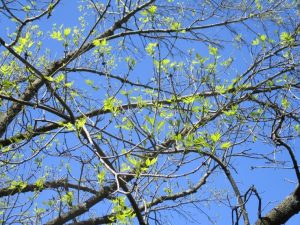
Mid-Spring weeks have arrived & shade trees like this green ash have begun leaf expansion. (Photo Credit: Steven K. Rettke, Rutgers Coop. Ext.)
Southern Red Mites (Oligonychus ilicis) (157 = Egg hatch): Some of the early 1st generation egg hatch of this cool season spider mite has commenced and may continue for another couple of weeks in the central sections of the state. The spruce spider mite that feeds on needle conifers often receives the most attention during the spring months, but the southern red spider mite can cause a great deal of aesthetic damage to broadleaf evergreens (especially Japanese holly, andromeda, & azalea). Adults are purple-red and the size of the period at the end of this sentence. Look for white or bronzed stippling damage on the foliage, particularly near the leaf midrib. Lower leaf surfaces often appear dusty because of the numerous eggshells and shed skins.

Southern red spider mite bronze-colored stippling symptoms are obvious on these azalea leaves. (Photo Credit: Steven K. Rettke, Rutgers Coop. Ext.)
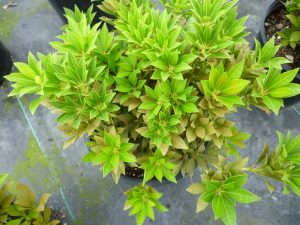
Southern red spider mite stippling symptoms to andromeda (Pieris japonica). The new upper growth this spring may disguise earlier feeding damage. (Photo Credit: Steven K. Rettke, Rutgers Coop. Ext.)
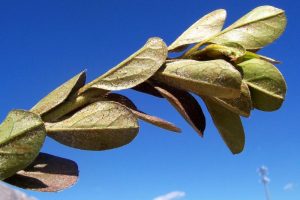
Dark-red eggs & active southern red spider mites are seen under azalea leaves. Also, white colored egg shells & mite cast skins are apparent. (Photo Credit: Steven K. Rettke, Rutgers Coop. Ext.)
If more than 10-15 mites can be knocked onto a beating tray/white paper & symptoms are beginning to appear, then control with horticultural oil or insecticidal soap. If more than 10% damage is evident, then use Avid, Hexygon, Florimite, or one of the labeled pyrethroids. Especially when using pyrethroids, return monitoring visits are important to evaluate effectiveness since eggs are not killed, but native mite predators are. Typically, additional sprays will be required with high infestations. Adults will be active into June, “hibernate” during summer heat, and then resume activity in late September.
Gypsy Moths (Lymantria dispar) (90-448 GDD = early instars/larvae): In New Jersey, for the past ten or more years the “golden moth” has been only a shadow of itself compared to the peak infestation periods of the early 1980’s. During the late 80’s & early 90’s, the number of acres defoliated by gypsy moth caterpillars decreased by 95-97% compared to the previous peak years. The Entomophaga maimaiga fungus has primarily been responsible for the devastation and collapse of this pest since its infamous former glory. This introduced Asian fungus was intentionally brought into the northeastern US states during the early 1980’s to lethally infect the gypsy moth caterpillar. Other beneficial impacts that have helped to cause the reductions in gypsy moth defoliations are from viral (Nuclear polyhedrosis virus or NPV), bacterial (Clostridium bacteria) as well as approximately a dozen beneficial insects (mostly parasitoids) introduced into the country during the 1970’s. All have combined, during most years, to help reduce NJ defoliations by significant levels over the past 30+ years.

Late 5th or 6th instar Gypsy Moth larvae can reach 3 inches in length & consume a square foot of foliage in 24 hours. (Photo Credit: Univ. of Maryland Coop. Ext.)
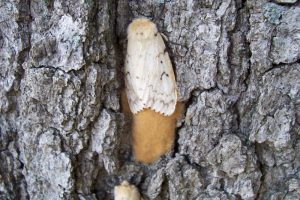
The adult female Gypsy Moth can lay between 400 to 1000 eggs within the yellow-colored egg mass. (Photo Credit: Steven K. Rettke, Rutgers Coop. Ext.)
However, occasionally outbreak years have still occurred. For example, in 2005 there was an 85% increase in defoliation in NJ compared to levels in 2004. The pathogenic fungus became relatively ineffective that year because of the unusually dry, late spring conditions. Despite this 2005 increase, the statewide gypsy moth aerial defoliation survey that year showed a total of 44,131 acres defoliated. Even with the 85% increase, it is almost insignificant when compared to the 799,000 NJ acres defoliated in the 1981 peak year. The years that followed from 2007 to 2009 had even greater defoliations that occurred (e.g., 2007 = 324,00 acres; 2008 = 340,00 acres & 2009 = 92,000 acres). However, since 2012, the NJ Department of Agriculture has not needed to implement the Gypsy Moth spray program that had previously been done for many years. In 2014, the number of NJ defoliated acres had dropped to only 1,330.
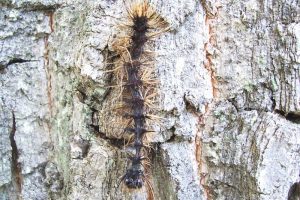
The dried-up dead carcass of a Gypsy Moth caterpillar killed by the Entomophaga maimaiga fungus. Press a knife against the body & it will crumble. (Photo Credit: Steven K. Rettke, Rutgers Coop. Ext.)
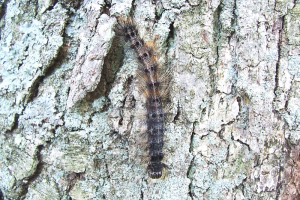
Gypsy Moth larva & Clostridium bacterial infection. Press a knife against the swelled lower body & a viscous ooze will emerge. (Photo Credit: Steven K. Rettke, Rutgers Coop. Ext.)
Despite these favorable numbers during the past decade, it is probably premature to think the state’s past gypsy moth problems are now permanently behind us & totally under control. Years into the future, the threat of climate change could certainly influence the favorable weather conditions that has previously helped the gypsy moth-killing fungus, Entomophaga maimaiga. At least, there may be the occasional period when the gypsy moth caterpillars can resurge & become a problem again at certain NJ sites like the years spanning from 2005 to 2009. Even worse, it is not impossible they could again reach the peak devastation years experienced during the early 1980’s. However, as things stand now, there are no trends that would indicate this will occur anytime soon.
Reference: “Gypsy Moths: They Came, They Ate, & Now They’re Gone.” By the Atlantic City Associated Press. March 29, 2019.
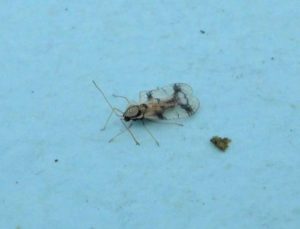
This adult Rhododendron Lace Bug has oval or rounded-cornered wings, as do all lace bug species that overwinter in the egg stage. (Photo Credit: Steven K. Rettke, Rutgers Coop. Ext.)
Evergreen Lace Bugs (~115 GDD = early 1st generation egg hatch): Foliar symptoms caused from these familiar landscape pests can soon begin to become apparent on the leaves of infested andromeda, rhododendron, & azalea shrubs. These mostly host specific pests overwinter as eggs inserted into the lower leaf veins. The common lace bug species with evergreen hosts include the azalea, rhododendron, & andromeda lace bugs. Lace bugs with deciduous hosts overwinter as adults (e.g., oak & hawthorn lace bugs). Adult lace bugs that overwinter as eggs have oval-shaped wings with rounded corners. Alternatively, adult lace bugs that feed on deciduous hosts have rectangular shaped wings with squared-off wing corners. For future consideration it is useful to remember that the eggs of all three evergreen lace bugs typically hatch at similar times. However, it is also important to remember that each lace bug species is mostly host specific to different plants. For example, within residential landscapes, it is common to have the various ericaceous shrubs growing adjacent to one another. Nonetheless, generally the lace bugs do not cross-feed onto other evergreen plant species, although occasionally it can occur (i.e., predominantly with the rhododendron lace bug).
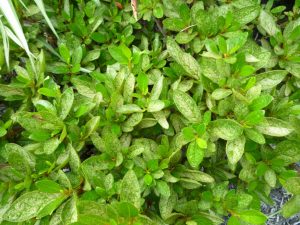
Azalea Lace Bug stippling symptoms on azalea leaves. All lace bugs feed on the undersides of foliage & remove green chlorophyll from plant leaf cells. (Photo Credit: Steven K. Rettke, Rutgers Coop. Ext.)
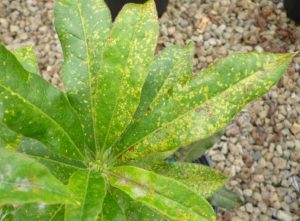
Rhododendron Lace Bug stippling symptoms on rhododendron leaves. Stippling from lace bugs are course in appearance compared to the fine stippling by spider mites. (Photo Credit: Steven K. Rettke, Rutgers Coop. Ext.)
Attempts to control eggs with dormant horticultural oils are futile since most of the eggs are not exposed. However, with good coverage, horticultural oils can successfully suppress lace bug nymphs and to a lesser degree the adults. Insecticidal soaps are exceptionally fast acting insecticides and can also be highly effective if proper coverage is achieved. If infestations of any of the evergreen lace bugs become a perennial problem, then Merit (imidacloprid) may be the product of choice. Field studies and observations have shown that soil injections of this material can maintain effective controls for at least 1 or 2 years. Therefore, it is probably unnecessary to apply Merit every year as a preventative against these pests.
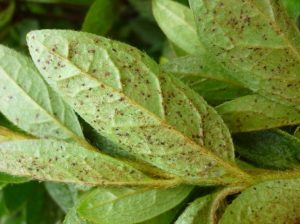
Azalea Lace Bug signs on the undersides of azalea leaves. The dark frass deposits are proof the lace bugs were previously present. (Photo Credit: Steven K. Rettke, Rutgers Coop. Ext.)
Nantucket Pine Tip Moth (Rhyacionia frustrana) (121-448 GDD = 1st generation larvae):
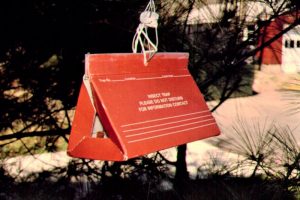
Nantucket Pine Tip Moth delta trap uses the female pheromone to capture adult male moths. The traps are not designed to directly provide controls, but are used to time preventative insecticides. (Photo Credit: Steven K. Rettke, Rutgers Coop. Ext.)
Pheromone traps will detect the initial emergence of the Nantucket Pine Tip Moth (NPTM) male moths. Adults in central NJ first emerge during mid to late April to lay their eggs on the tips of new growth of two and three needle pines. Newly hatched larvae feed in the needles first and then enter the buds and stems. This feeding causes tip dieback (brown, dead tip growth).
For small populations, prune out the dying tips and destroy. If large populations are anticipated, then hang out the pheromone traps to monitor for the adult flight period. Adult NPTM’s are ¼ inch long, with gray wings mottled with rust-colored patches. When the first moth is caught, count 10 to 14 days, and apply acephate (Orthene), cyfluthrin (Tempo2), or fluvalinate (Mavrik). Imidacloprid (Merit) is effective when proper lead-time is provided (4 to 8 weeks with soil injections or drenches). Merit is usually not effective against caterpillars (i.e., therefore, the NPTM is an exception to the rule). Be prepared for a second generation in July.
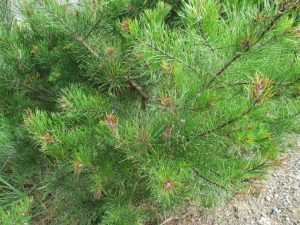
Nantucket Pine Tip Moth infesting multiple twig shoots of this Jersey scrub pine (Pinus virginiana). (Photo Credit: Steven K. Rettke, Rutgers Coop. Ext.)
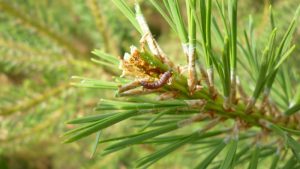
Nantucket Pine Tip Moth mature larva caterpillar emerging from branch terminal tip. Initially the young larvae feed within needles, but then move into terminal buds & twig growing tips as they become larger. (Photo Credit: Steven K. Rettke, Rutgers Coop. Ext.).
Birch Leaf Miner (Fenusa pusilla) (123-290 GDD = adult egg laying / egg hatch):
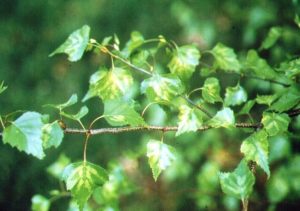
Birch Leaf Miner feeding symptoms are apparent. If leaf mining becomes extensive, then the leaves will defoliate. (Photo Credit: Deborah Smith-Fiola, Former Rutgers Agricultural Agent)
Birch leaf miners were once considered to be a major key insect pest within our NJ landscapes. Today, they appear to be well below the radar to what they previously were. During the 1970’s & 1980’s, many Asian & European birches were planted in our landscapes in addition to our native gray & paper birches. All these birch species are highly susceptible to the birch leaf miner (BLM) insect. Most of the non-native birch species have since died-out, as they frequently succumbed to infestations from the bronze birch borer in less than a decade after initial planting.
For the past 25-30 years, the birch species of choice for planting has been the river birch (Betula nigra). This tree species has at least a partial resistance to the BLM (also highly resistant to the bronze birch borer), since the pest has difficulties completing its’ life cycle within the leaves. Also, during the 1990’s, a number of beneficial parasitoids against the BLM were released within the northeast section of the country. As a result, these beneficials could also be playing a major role in the demise of this former key NJ pest.
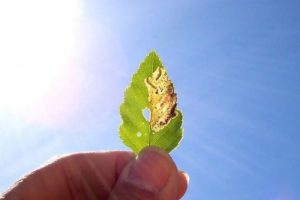
Active Birch Leaf Miner sawfly larvae can be observed feeding within the leaf. The darker colored areas are an accumulation of insect frass. (Photo Credit: Steven K. Rettke, Rutgers Coop. Ext.)
The black, ¼ inch sawfly adults have now become active or soon will be within the next week or two (i.e., they become active just as the new leaf buds begin to expand). They will hover around the newly emerged foliage and begin laying eggs within the tissue. Yellow sticky traps can be placed in the tree canopy to monitor for the presence of adults. Early larval feeding damage appears as small, off-color patches in the leaf. Larvae will feed by mining between the leaf epidermis layers for only 10-14 days, before dropping to the ground to pupate. Be sure to check for larval activity since spraying leaves with nothing inside is of no value. Monitor for active larvae within leaves by holding the leaf up to sunlight. Heavy infestations may cause entire trees to appear brown and scorched, as mined tissue dies.
Control larvae when eggs first hatch (or when early damage is first noticed) with a spray treatment having translaminar properties. Imidacloprid (Merit) is a systemic & will work well but needs some lead-time. The use of granular or drench applications will require at least 30 days or longer to move throughout the tree canopy.
Hemlock Woolly Adelgids (Adelges tsugae) (150 GDD = 10% egg hatch): Imidacloprid (Merit) applied as a soil injection or drench has been the material of choice for the past few decades to combat this pest. This approach is especially effective for the protection of taller hemlocks when foliar sprays may prove difficult. Since hemlock woolly adelgids (HWA) essentially never leave the host, Merit can be applied anytime during the year if the ground is not frozen and adequate soil moisture is present. It is usually best to make most applications during the spring or fall months. With larger trees it may require 6 to 8 weeks before sufficient concentrations of the active ingredient is translocated into the upper canopy.
When using horticultural oils or other labeled insecticides avoid making spray treatments this time of year (early spring). HWA eggs will not begin to hatch until late April or early May in the northern half of the state. At 150 GDD’s, only about 10% egg hatch of the crawlers has occurred. At 350 GDD (i.e., 2nd half of May) only about 50% egg hatch has occurred. Presently, most of the egg-laying females are already dead and the eggs are clumped tightly together within the protective white wooly wax. Although an oil or soap spray may destroy contacted crawlers and exposed outer eggs within the clumps, most of the unhatched eggs will not be affected. (Insecticidal soaps do not have strong ovicidal properties.) Egg hatching and crawler emergence can extend for 6 weeks or more. To avoid multiple sprays during the spring, it is more efficient to wait until early to mid-June after all the eggs have hatched and the exposed, settled crawlers are all neatly lined-up at the base of leaf petioles (i.e., will have a white fringe of wax circling their bodies). Being patient to apply sprays during this control window can save time and material as well as being the most effective.
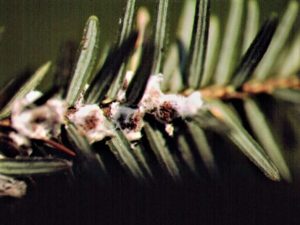
Hemlock Woolly Adelgid eggs have now all been laid within the white woolly masses located at the base of needles. Egg hatching extends into June for over a period of 6-weeks or more. (Photo Credit: Steven K. Rettke, Rutgers Coop. Ext.)
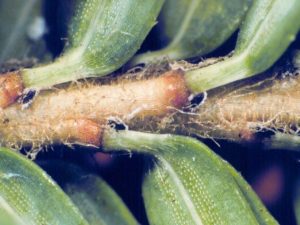
Hemlock Woolly Adelgid crawlers will settle at petioles of individual hemlock needles & begin to feed. The white wax encircling the individual nymphs signify all eggs have hatched. (Photo Credit: John Davidson, UMD Coop. Ext.)
Plant Leaf Galls (Eriophyid mite spp.): Leaf galls observed on deciduous woody ornamental plants often attract curiosity & considerable attention because of their unusual shapes & colors. These galls cause abnormal growths or blisters to develop in leaf plant tissues due to the introduction of a foreign substance. The galls are made up of plant cells which have been stimulated to undergo rapid division and growth by the presence of the foreign substance.
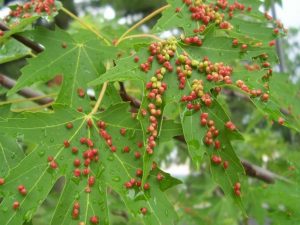
Maple Bladder Gall Mites infesting silver maple leaves. Cutting & opening-up individual galls will uncover many dozens of tiny eriophyid mites. (Photo Credit: Steven K. Rettke, Rutgers Coop. Ext.)
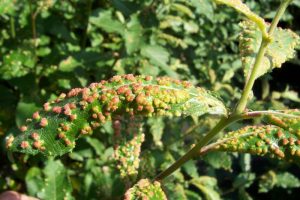
Eriophyid Leaf Gall Mites on willow leaves. Willows are susceptible to leaf gall mites & symptoms can sometimes become extreme. Leaf photosynthesis can become compromised. (Photo Credit: Steven K. Rettke, Rutgers Coop. Ext.)
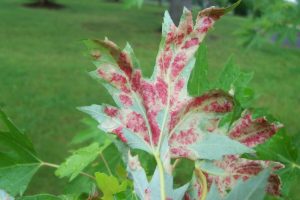
Maple Erinium Gall Mites on silver maple produce a reddish, beaded gall appearance. Sometimes they are mistaken as fungal leaf infections. They are another species of eriophyid mites. (Photo Credit: Steven K. Rettke, Rutgers Coop. Ext.)
Most of the leaf galls on trees & shrubs are caused by eriophyid mites that often are no larger than 0.5 mm in size. These mites are elongated, spindled shaped & have only 2-pairs of legs located near the head. Detecting their presence may require magnification with a 15x-20x hand-lens. They overwinter in bark crevices & under bud scales. Galls will form on susceptible plants when overwintering eriophyid mite spp. deposit their eggs in rapidly growing plants parts during early spring. Chemical fluids may be deposited simultaneously, causing a plant hormonal response. This stimulates tissue to grow over the eggs. Upon hatching, the protected mites feed internally on the gall tissue until they complete their life cycles. The fantastic cellular growth of various plant galls has been of interest to scientists conducting cancer research.
Most leaf gall types only cause cosmetic damage to ornamental plants & therefore control measures are typically considered unnecessary. However, plants with a history of extreme eriophyid mite infestations can receive a horticultural oil spray to kill overwintering stages. (i.e., keep oil percentage rates low this late into the spring.) The most effective spray window is narrow since it needs to be applied immediately at bud break.

